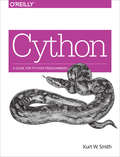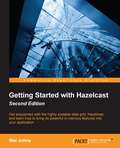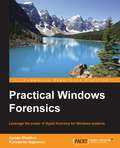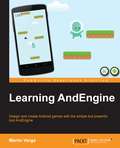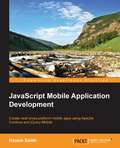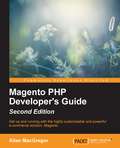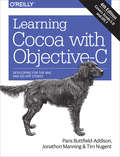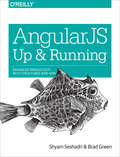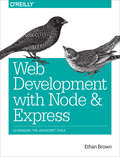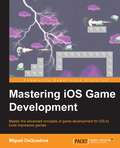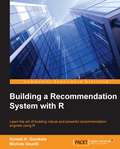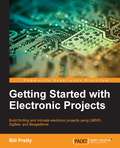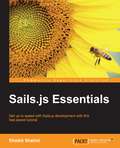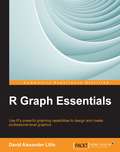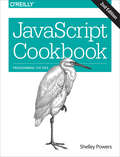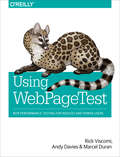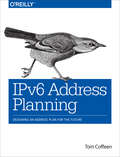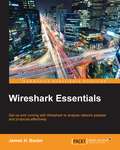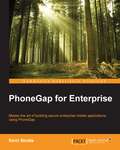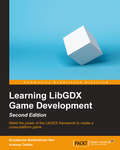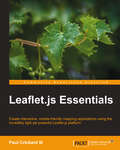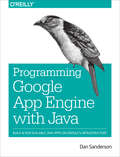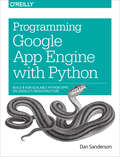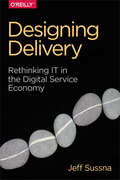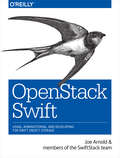- Table View
- List View
Cython
by Kurt W. SmithBuild software that combines Python's expressivity with the performance and control of C (and C++). It's possible with Cython, the compiler and hybrid programming language used by foundational packages such as NumPy, and prominent in projects including Pandas, h5py, and scikits-learn. In this practical guide, you'll learn how to use Cython to improve Python's performance--up to 3000x-- and to wrap C and C++ libraries in Python with ease.Author Kurt Smith takes you through Cython's capabilities, with sample code and in-depth practice exercises. If you're just starting with Cython, or want to go deeper, you'll learn how this language is an essential part of any performance-oriented Python programmer's arsenal.Use Cython's static typing to speed up Python codeGain hands-on experience using Cython features to boost your numeric-heavy PythonCreate new types with Cython--and see how fast object-oriented programming in Python can beEffectively organize Cython code into separate modules and packages without sacrificing performanceUse Cython to give Pythonic interfaces to C and C++ librariesOptimize code with Cython's runtime and compile-time profiling toolsUse Cython's prange function to parallelize loops transparently with OpenMP
Getting Started with Hazelcast - Second Edition
by Mat JohnsThis book is a great introduction for Java developers, software architects, or DevOps looking to enable scalable and agile data within their applications. <P><P>Providing in-memory object storage, cluster-wide state and messaging, or even scalable task execution, Hazelcast helps solve a number of issues that have troubled technologists for years.
Practical Windows Forensics
by Konstantin Sapronov Ayman ShaabanLeverage the power of digital forensics for Windows systems About This Book * Build your own lab environment to analyze forensic data and practice techniques. * This book offers meticulous coverage with an example-driven approach and helps you build the key skills of performing forensics on Windows-based systems using digital artifacts. * It uses specific open source and Linux-based tools so you can become proficient at analyzing forensic data and upgrade your existing knowledge. Who This Book Is For This book targets forensic analysts and professionals who would like to develop skills in digital forensic analysis for the Windows platform. You will acquire proficiency, knowledge, and core skills to undertake forensic analysis of digital data. Prior experience of information security and forensic analysis would be helpful. You will gain knowledge and an understanding of performing forensic analysis with tools especially built for the Windows platform. What You Will Learn * Perform live analysis on victim or suspect Windows systems locally or remotely * Understand the different natures and acquisition techniques of volatile and non-volatile data. * Create a timeline of all the system actions to restore the history of an incident. * Recover and analyze data from FAT and NTFS file systems. * Make use of various tools to perform registry analysis. * Track a system user's browser and e-mail activities to prove or refute some hypotheses. * Get to know how to dump and analyze computer memory. In Detail Over the last few years, the wave of the cybercrime has risen rapidly. We have witnessed many major attacks on the governmental, military, financial, and media sectors. Tracking all these attacks and crimes requires a deep understanding of operating system operations, how to extract evident data from digital evidence, and the best usage of the digital forensic tools and techniques. Regardless of your level of experience in the field of information security in general, this book will fully introduce you to digital forensics. It will provide you with the knowledge needed to assemble different types of evidence effectively, and walk you through the various stages of the analysis process. We start by discussing the principles of the digital forensics process and move on to show you the approaches that are used to conduct analysis. We will then study various tools to perform live analysis, and go through different techniques to analyze volatile and non-volatile data. Style and approach This is a step-by-step guide that delivers knowledge about different Windows artifacts. Each topic is explained sequentially, including artifact analysis using different tools and techniques. These techniques make use of the evidence extracted from infected machines, and are accompanied by real-life examples.
Learning AndEngine
by Martin VargaIf you are a beginner to AndEngine, or mobile game development in general, and you are looking for a simple way to start making games for Android, this book is for you. You should already know the basics of Java programming, but no previous game development experience is required.
JavaScript Mobile Application Development
by Hazem SalehIf you are a native mobile developer, with some familiarity with the common web technologies of JavaScript, CSS, and HTML, or if you are a web developer, then this learning guide will add great value and impact to your work. Learning how to develop mobile applications using Apache Cordova is of particular importance if you are looking to develop applications on a variety of different platforms efficiently.
Magento PHP Developer's Guide - Second Edition
by Allan MacgregorThis book is written for PHP developers who are familiar with frameworks such as Zend or CakePHP and want to start developing and working with Magento. No prior knowledge of Magento is required.
Learning Cocoa with Objective-C
by Tim Nugent Jonathon Manning Paris Buttfield-AddisonGet up to speed on Cocoa and Objective-C, and start developing applications on the iOS and OS X platforms. If you don't have experience with Apple's developer tools, no problem! From object-oriented programming to storing app data in iCloud, the fourth edition of this book covers everything you need to build apps for the iPhone, iPad, and Mac.You'll learn how to work with the Xcode IDE, Objective-C's Foundation library, and other developer tools such as Event Kit framework and Core Animation. Along the way, you'll build example projects, including a simple Objective-C application, a custom view, a simple video player application, and an app that displays calendar events for the user.Learn the application lifecycle on OS X and iOSWork with the user-interface system in Cocoa and Cocoa TouchUse AV Foundation to display video and audioBuild apps that let users create, edit, and work with documentsStore data locally with the file system, or on the network with iCloudDisplay lists or collections of data with table views and collection viewsInteract with the outside world with Core Location and Core MotionUse blocks and operation queues for multiprocessing
AngularJS: Up and Running
by Brad Green Shyam SeshadriIf you want to get started with AngularJS, either as a side project, an additional tool, or for your main work, this practical guide teaches you how to use this meta-framework step-by-step, from the basics to advanced concepts. By the end of the book, you'll understand how to develop a large, maintainable, and performant application with AngularJS.Guided by two engineers who worked on AngularJS at Google, you'll learn the components needed to build data-driven applications, using declarative programming and the Model-view-controller pattern. You'll also learn how to conduct unit tests on each part of your application.Learn how to use controllers for moving data to and from viewsUnderstand when to use AngularJS services instead of controllersCommunicate with the server to store, fetch, and update data asynchronouslyKnow when to use AngularJS filters for converting data and values to different formatsImplement single-page applications, using ngRoute to select views and navigationDive into basic and advanced directives for creating reusable componentsWrite an end-to-end test on a live version of your entire applicationUse best practices, guidelines, and tools throughout the development cycle
Web Development with Node and Express
by Ethan BrownThe Express web application framework for Node strikes the ideal balance between a robust framework and no framework at all. Many web frameworks try to do so much that they become inflexible and overly complicated, having a negative effect on both learning curve and ability to customize. Express takes a much more agnostic approach, allowing developers a free hand in their architecture choices. It is a joy to work with, and this book is designed not only to introduce the framework, but also to provide some guidance about how to go about doing things that more elaborate (and inflexible) frameworks provide.Even though there is plenty of material on the topic of Express alone, Web Development with Node and Express will provide you additional value because it also covers best practices in web architecture. Ideal for those new to JavaScript, this book also shows experienced JavaScript developers have started to look towards Express as a viable alternative for web development.As someone who deals every day with the complexities of real-world websites, author Ethan Brown offers tremendous wisdom and experience for people interested in producing high-quality, fast, maintainable websites that are friendly to SEO and analytics.This book covers Express 4.0.
Mastering iOS Game Development
by Miguel DequadrosMaster the advanced concepts of game development for iOS to build impressive games About This Book * Create a complete game with advanced techniques through the course of the book using in-depth, hands-on instructions * Learn how to multi-task and improve performance optimization in your game playing experience * The author, Miguel, has 11 years of iOS game development using xcode and has released over 10 games to the Apple AppStoreMaster player movement using touch controls as well as discuss motion controls Who This Book Is For This book is for those who have created an iOS game already and want to hone their skills. A reasonable level of knowledge and an understanding of the core elements and applications would be helpful. What You Will Learn * Blast off and start developing fun games * Optimize the assets for the best performance in the game app * Master player movement using touch controls as well as discuss motion controls * Perform bug Squashing by testing and debugging * Design interesting various characters and enemies for your game * Test your game on both, the simulator on the computer and on real devices * Tweak and fine tune the code and graphics before the release of your app * Uncover some awesome new gameplay by adding in multiplayer elements, to get more people playing together In Detail iOS is an operating system for Apple manufactured phones and tablets. Mobile gaming is one of the fastest-growing industries, and compatibility with iOS is now becoming the norm for game developers. SpriteKit is part of the native SDK from Apple, and enables developers to make simple entry into game development without unnecessary overhead and a long learning process. SpriteKit also provides other functionality that is useful for games, including basic sound playback support and physics simulation. In addition, Xcode provides built-in support for SpriteKit so that you can create complex special effects and texture atlases directly in Xcode. This combination of framework and tools makes SpriteKit a good choice for games and other apps that require similar kinds of animation. Become a master in iOS game development through this fast and fun guide! In the beginning, we'll tell you everything you need to plan and design your game. You'll then start developing your game through step-by-step instructions using the various built-in technologies of Xcode. From there on, we discuss how to deploy your game to the iOS App Store, as well as monetizing it to make more revenue. You will also learn advanced techniques to improve your game playing experience, including better multi-tasking, improved performance optimization, battery management, and more. To end the book off, we'll show you how to update your game with different features, then port the update to the App Store. Style and approach This book provides an easy-to-understand and fun approach to game development, with step-by-step instructions and detailed explanation of each block of code. The topics covered range from easy to advanced, so buckle up for a fast-paced ride!
Building a Recommendation System with R
by Suresh K. Gorakala Michele UsuelliLearn the art of building robust and powerful recommendation engines using R About This Book * Learn to exploit various data mining techniques * Understand some of the most popular recommendation techniques * This is a step-by-step guide full of real-world examples to help you build and optimize recommendation engines Who This Book Is For If you are a competent developer with some knowledge of machine learning and R, and want to further enhance your skills to build recommendation systems, then this book is for you. What You Will Learn * Get to grips with the most important branches of recommendation * Understand various data processing and data mining techniques * Evaluate and optimize the recommendation algorithms * Prepare and structure the data before building models * Discover different recommender systems along with their implementation in R * Explore various evaluation techniques used in recommender systems * Get to know about recommenderlab, an R package, and understand how to optimize it to build efficient recommendation systems In Detail A recommendation system performs extensive data analysis in order to generate suggestions to its users about what might interest them. R has recently become one of the most popular programming languages for the data analysis. Its structure allows you to interactively explore the data and its modules contain the most cutting-edge techniques thanks to its wide international community. This distinctive feature of the R language makes it a preferred choice for developers who are looking to build recommendation systems. The book will help you understand how to build recommender systems using R. It starts off by explaining the basics of data mining and machine learning. Next, you will be familiarized with how to build and optimize recommender models using R. Following that, you will be given an overview of the most popular recommendation techniques. Finally, you will learn to implement all the concepts you have learned throughout the book to build a recommender system. Style and approach This is a step-by-step guide that will take you through a series of core tasks. Every task is explained in detail with the help of practical examples.
Getting Started with Electronic Projects
by Bill PrettyThis book is aimed at hobbyists with basic knowledge of electronics circuits. Whether you are a novice electronics project builder, a ham radio enthusiast, or a BeagleBone tinkerer, you will love this book.
Sails.js Essentials
by Shaikh ShahidGet up to speed with Sails.js development with this fast-paced tutorial About This Book * Gain expertise in building web apps with Sails.js * Develop apps such as real-time chat app and more in no time * Helps you understand how MVC framework works in Node.js and how to make it work for you Who This Book Is For This book is for web developers who want to build web apps with Sails.js. Proficiency with JavaScript and Node.js is assumed, as well as familiarity with web development concepts. Familiarity with the MEAN (Mongo, Express, Angular, and Node) stack would be an added advantage. What You Will Learn * Find out to quick-start Sails.js and develop production-ready apps * Understand how to apply the MVC model of software development in Node.js using Sails.js * Discover how to write quality code using Sails.js * Integrate third-party APIs and databases such Mongo and MySQL in Sails.js * Get to know the advantages and importance of the MVC framework in software development In Detail Sails.js makes it easy to build custom, enterprise-grade Node.js apps. It is designed to emulate the familiar MVC pattern of frameworks, but with support for the requirements of modern apps: data-driven APIs with a scalable, service-oriented architecture. This book will provide practical examples to get you started with Sails.js and get you develop production-ready apps in no time. We will take you from a Node.js web server and single threading system to a general MVC architecture. You will then learn to develop applications that you might be already familiar with using Sails.js. Finally, we will show you how to create a chat app and a to-do application, and improve code quality using JSHINT and JSCS. Style and approach This practical and easy-to-follow yet comprehensive guide will help you get to grips with the Sails.js framework. Each topic is explained and placed in context, and for the more inquisitive, there are more details of the concepts used.
R Graph Essentials
by David Alexander LillisThis book is targeted at R programmers who want to learn the graphing capabilities of R. This book will presume that you have working knowledge of R.
JavaScript Cookbook
by Shelley PowersWhy reinvent the wheel every time you run into a problem with JavaScript? This cookbook is chock-full of code recipes that address common programming tasks, as well as techniques for building web apps that work in any browser. Just copy and paste the code samples into your project -- you'll get the job done faster and learn more about JavaScript in the process. You'll also learn how to take advantage of the latest features in ECMAScript 5 and HTML5, including the new cross-domain widget communication technique, HTML5's video and audio elements, and the drawing canvas. You'll find recipes for using these features with JavaScript to build high-quality application interfaces. Create interactive web and desktop applications Work with JavaScript objects, such as String, Array, Number, and Math Use JavaScript with Scalable Vector Graphics (SVG) and the canvas element Store data in various ways, from the simple to the complex Program the new HTML5 audio and video elements Implement concurrent programming with Web Workers Use and create jQuery plug-ins Use ARIA and JavaScript to create fully accessible rich internet applications
Using WebPageTest
by Andy Davies Marcel Duran Rick ViscomiLearn basic and advanced uses of WebPagetest, the performance measurement tool for optimizing websites. This practical guide shows users new to this tool how run tests and interpret results, and helps experienced users gain a better and more thorough understanding of hidden features in WebPagetest that make testing easier.Written by WebPagetest power users and performance experts, this book will help web developers and frontend engineers solve the problem of slow sites. Topics include:Basic test setup--shows beginners how to get meaningful resultsAdvanced test setup--provides another level of technical depth by explaining features not thoroughly documented at webpagetest.orgAnalysis of results--helps you understand of how to interpret test resultsPrivate instance setup--teaches power users the intricacies of the webpagetest private instance and how it worksAPI and external tools--provides a detailed reference for the API and demonstrates tools already using the API to extend WebPagetest
IPv6 Address Planning
by Tom CoffeenIf you're ready to join the move to IPv6, this comprehensive guide gets you started by showing you how to create an effective IPv6 address plan. In three example-driven sections--preparation, design, and maintenance--you'll learn principles and best practices for designing, deploying, and maintaining an address plan far beyond what's possible with IPv4 networks.During the course of the book, you'll walk through the process of building a sample address plan for a fictional company. Enterprise IT network architects, engineers, and administrators will see firsthand how IPv6 provides opportunities for creating an operationally efficient plan that's scalable, flexible, extensible, manageable, and durable.Explore IPv6 addressing basics, including representation, structure, and typesManage risks and costs by using a three-phase approach for deploying IPv6Dig into IPv6 subnetting methods and learn how they differ from IPv4Determine the appropriate size and type of the IPv6 allocation you requireApply current network management tools to IPv6Use IPv6 renumbering methods that enable greater network scale and easier integrationImplement policies and practices to keep IPv6 addresses reachable
Wireshark Essentials
by James H. BaxterThis book is aimed at IT professionals who want to develop or enhance their packet analysis skills. Basic familiarity with common network and application services terms and technologies is assumed; however, expertise in advanced networking topics or protocols is not required. Readers in any IT field can develop the analysis skills specifically needed to complement and support their respective areas of responsibility and interest.
PhoneGap for Enterprise
by Kerri ShottsThis book is intended for developers who wish to use PhoneGap to develop useful, rich, secure mobile applications for their enterprise environment. The book assumes you have working knowledge of PhoneGap, HTML5, CSS3, and JavaScript, and a reasonable understanding of networking and n-tier architectures.
Learning LibGDX Game Development - Second Edition
by Suryakumar Balakrishnan Nair Andreas OehlkeThis book is aimed at indie and existing game developers as well as those who want to get started with game development using LibGDX. Basic knowledge of Java programming and game development is required.
Leaflet.js Essentials
by Paul Crickard IIIIf you are a web developer working with geospatial concepts and mapping APIs, and you want to learn Leaflet to create mapping solutions, this book is for you. You need to have a basic knowledge of working with JavaScript and performing web application development.
Programming Google App Engine with Java
by Dan SandersonThis practical guide shows intermediate and advanced web and mobile app developers how to build highly scalable Java applications in the cloud with Google App Engine. The flagship of Google's Cloud Platform, App Engine hosts your app on infrastructure that grows automatically with your traffic, minimizing up-front costs and accommodating unexpected visitors. You'll learn hands-on how to perform common development tasks with App Engine services and development tools, including deployment and maintenance.For Java applications, App Engine provides a J2EE standard servlet container with a complete Java 7 JVM and standard library. Because App Engine supports common Java API standards, your code stays clean and portable.Get a hands-on introduction to App Engine's tools and features, using an example applicationSimulate App Engine on your development machine directly from EclipseStructure your app into individually addressable modules, each with its own scaling configurationExploit the power of the scalable Cloud Datastore, using queries, transactions, and data modeling with JPAUse Cloud SQL for standard relational databases with App Engine applicationsLearn how to deploy, manage, and inspect your application on Google infrastructure
Programming Google App Engine with Python
by Dan SandersonThis practical guide shows intermediate and advanced web and mobile app developers how to build highly scalable Python applications in the cloud with Google App Engine. The flagship of Google's Cloud Platform, App Engine hosts your app on infrastructure that grows automatically with your traffic, minimizing up-front costs and accommodating unexpected visitors. You'll learn hands-on how to perform common development tasks with App Engine services and development tools, including deployment and maintenance.App Engine's Python support includes a fast Python 2.7 interpreter, the standard library, and a WSGI-based runtime environment. Choose from many popular web application frameworks, including Django and Flask.Get a hands-on introduction to App Engine's tools and features, using an example applicationSimulate App Engine on your development machine with tools from Google Cloud SDKStructure your app into individually addressable modules, each with its own scaling configurationExploit the power of the scalable Cloud Datastore, using queries, transactions, and data modeling with the ndb libraryUse Cloud SQL for standard relational databases with App Engine applicationsLearn how to deploy, manage, and inspect your application on Google infrastructure
Designing Delivery
by Jeff SussnaNow that we're moving from a product economy to a digital service economy, software is becoming critical for navigating our everyday lives. The quality of your service depends on how well it helps customers accomplish goals and satisfy needs. Service quality is not about designing capabilities, but about making--and keeping--promises to customers.To help you improve customer satisfaction and create positive brand experiences, this pragmatic book introduces a transdisciplinary approach to digital service delivery. Designing a resilient service today requires a unified effort across front-office and back-office functions and technical and business perspectives. You'll learn how make IT a full partner in the ongoing conversations you have with your customers.Take a unique customer-centered approach to the entire service delivery lifecycleApply this perspective across development, operations, QA, design, project management, and marketingImplement a specific quality assurance methodology that unifies those disciplinesUse the methodology to achieve true resilience, not just stability
OpenStack Swift
by Joe ArnoldGet up and running with OpenStack Swift, the free, open source solution for deploying high-performance object storage clusters at scale. In this practical guide, Joe Arnold, co-founder and CEO of SwiftStack, brings you up-to-speed on the basic concepts of object storage and walks you through what you need to know to plan, build, operate, and measure the performance of your own Swift storage system.Object storage is essential today with the growth of web, mobile, and software-as-a-service (SaaS) applications. This book helps you through the process, with separate sections on application development, installation, administration, and troubleshooting.Learn Swift's concepts for organizing, distributing, and serving dataExplore basic and advanced features of the Swift RESTful APIDelve into Swift's many client libraries, including useful Python featuresWrite middleware to customize and simplify your storage systemUnderstand requirements for planning a Swift deployment--including your specific use caseLearn options for coaxing the best performance from your clusterGet best practices for daily operations, such as monitoring and planning capacity additionsPick up techniques for testing and benchmarking your Swift cluster
